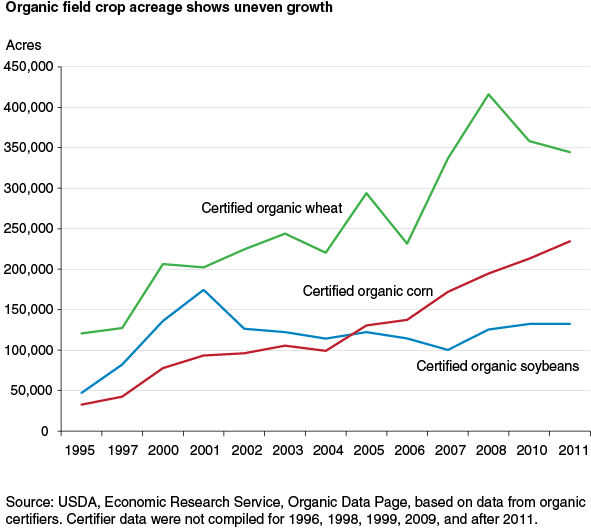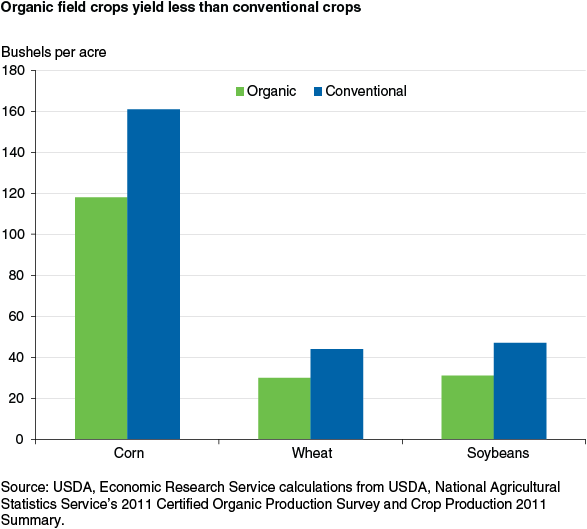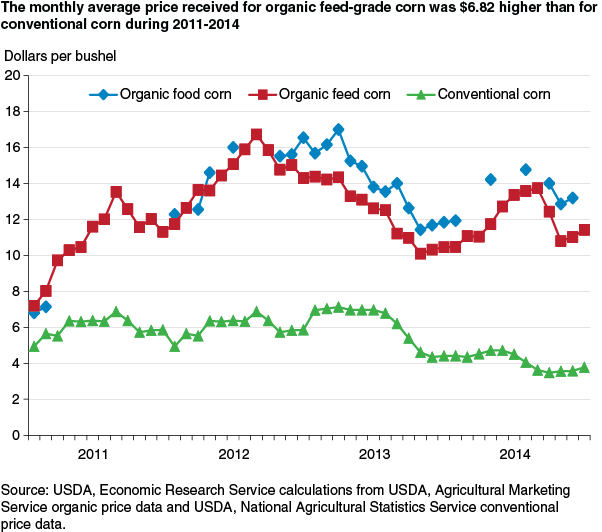Despite Profit Potential, Organic Field Crop Acreage Remains Low
- by William D. McBride and Catherine Greene
- 11/2/2015
Highlights
- USDA survey data show that organic systems had lower yields and higher total economic costs than conventional systems.
- Organic corn and soybeans have been profitable, primarily due to the significant price premiums paid for certified organic crops that more than offset the additional economic costs. Organic wheat has been less profitable.
- Despite potentially higher returns, adoption of the organic approach among U.S. field crop producers remains low, likely due to low crop yields and challenges of effective weed control, among other factors.
U.S. crop acres under USDA certified organic systems have grown rapidly since the National Organic Program (NOP) was implemented in 2002. Organic crop acreage increased from about 1.3 million to almost 3.1 million acres between 2002 and 2011. While acreage for some major field crops increased substantially, growth was modest for others. Among three major field crops—corn, soybeans, and wheat—certified organic production of corn increased the most. Certified organic wheat acres were the highest, but declined after 2009. Recent USDA survey data show corn acreage up 24 percent, soybean acreage up 3 percent, but wheat acreage down 3 percent between 2011 and 2014.
Despite the strong interest in organic food in the United States, overall adoption of organic corn, soybeans, and wheat remains low, standing at less than 1 percent of the total acreage of each crop. One reason for the low levels of organic adoption among U.S. field crop producers may be a lack of information about the relative costs and returns of organic and conventional production systems on commercial farms, and the performance of farms choosing the organic approach. Researchers have studied organic crop production in a long-term experimental setting, but little has been reported about the commercial production of organic field crops. To cast light on this issue, ERS researchers used actual farm data to estimate the difference in costs of production that can be attributed to producing certified organic crops and use these estimates to calculate the price premiums that make organic systems profitable when compared with conventional systems (see, “Data and Production Costs” box).
Organic Yields Lower Than Conventional
Data from long-term cropping system experiments in Iowa, Pennsylvania, and other States suggest that organic crop production can bring significant returns. The data show similar conventional and organic yields and lower organic production costs. However, farm data from USDA producer surveys show organic crop yields to be much lower than those of conventional production. The yield differences estimated from USDA farm data are similar to those estimated by comparing USDA’s 2011 Certified Organic Production Survey with USDA’s 2011 Crop Production Report. These data show organic corn yields to be 41 bushels per acre less than conventional yields, organic wheat yields to be 9 bushels per acre less, and organic soybean yields to be 12 bushels per acre less.
In USDA organic surveys, producers reported that achieving yields was one of the most difficult aspects of organic production. The yield differences revealed by survey data may be due to the unique problems encountered by organic systems outside of the experimental setting, such as effective weed control. Genetically modified conventional seed varieties commonly used for corn and soybean production may also be higher yielding than standard organic seed varieties. In some organic field crop systems, such as for wheat and soybeans, lower yields may be due to the high percentage of organic growers who use lower yielding food-grade varieties. Most of the organic wheat and soybean production is used to make food items. Most organic corn is fed to livestock.
Organic Costs More Per-Bushel
Similar to findings from experimental data, which primarily examine only operating costs, analysis of USDA survey data show mean operating, and operating plus capital costs per acre for crop production were generally less for organic than for conventional farms. For example, total operating costs and operating plus capital costs per acre for organic corn were about $80 and $50 per acre lower, respectively, than for conventional corn. The mean difference in total economic costs per acre was not significant, but the composition of costs varied substantially for conventional and organic corn. Conventional corn growers had significantly higher seed, fertilizer, and chemical costs than organic growers, but lower costs for fuel, repairs, capital, and labor, as organic systems substituted manure and field operations for fertilizers and chemicals. Organic producers had higher fuel and capital costs because they used more field operations, particularly for tillage. Labor costs for organic production were also significantly higher.
Mean total economic costs per bushel were significantly higher among the organic crop farms due largely to lower crop yields. Researchers used alternative statistical methods to measure the cost difference between organic and conventional corn, wheat, and soybean production from farm survey data as if they were in an experimental setting. Organic transition and certification cost estimates were then added to the measured cost differences.
Organic Corn and Soybean Production Had Higher Returns
Comparison of the additional costs associated with organic production with historic price premiums (the difference between organic and conventional crop prices) provides an indication of the returns associated with organic field crop production. Organic corn prices ranged between about $5 to $10 per bushel higher than conventional corn prices during 2011-14, while the economic cost difference was $1.92 to $2.27 higher, indicating significant profit potential from organic corn. Likewise, organic soybean prices averaged about $10 to $15 per bushel higher than conventional soybeans during the same period, creating price premiums high enough to easily cover the additional economic costs of $6.62 to $7.81 per bushel of organic soybean production.
The gap between average organic and conventional wheat prices depended on the type of wheat produced. Throughout 2011-14, price premiums for organic food wheat increased, reaching above $10 per bushel, much higher than the economic cost differential of $3.90 to $4.46 per bushel between organic and conventional wheat production. However, farm prices of organic feed wheat were only $1-$4 per bushel higher than those for conventional wheat, often below the additional economic costs of organic wheat production.
The yield, price, and cost differences were used to estimate the per acre returns to organic versus conventional production for each crop. Average additional economic costs of $83 to $98 per acre for corn, $55 to $62 per acre for wheat, and $106 to $125 per acre for soybeans are incurred from organic production. These cost estimates are based on the farm survey yield and cost data. Estimates of the average difference in net returns per acre for organic versus conventional production were positive and highest for corn ($51 to $66 per acre), followed by soybeans ($22 to $41 per acre), but negative for wheat (-$9 to -$2 per acre).
| Crop | Difference between organic and conventional economic costs ($ per bushel) |
Difference between organic and conventional economic costs ($ per acre) |
Difference between organic and conventional number of returns above economic costs |
|---|---|---|---|
| Corn | 1.92 to 2.27 | 83 to 98 | 51 to 66 |
| Wheat | 3.90 to 4.46 | 55 to 62 | -9 to -2 |
| Soybeans | 6.62 to 7.81 | 106 to 125 | 22 to 41 |
| Source: USDA, Economic Research Service calculations using Agricultural Resource Management Survey data and include production cost differences plus organic transition and certification costs. The range of costs and returns was generated from alternative statistical methods. | |||
Despite Potentially Higher Returns, Organic Acreage Remains Low
The main reason that organic returns were higher than conventional returns was the price premiums paid for organic crops. Price premiums received for organic crops were generally above the estimated additional economic costs of organic production for most crops during 2011-14. Estimates of the difference in net returns per acre for organic versus conventional production showed positive economic profit for organic corn and soybeans relative to conventional crops, consistent with expanded organic acreage of those two crops in recent years. Estimates of an economic loss per acre for organic versus conventional wheat is consistent with the recent decline in organic wheat acreage.
Despite these potentially higher returns from organic production, adoption of the organic approach among U.S. field crop producers remains low. One possible reason is the ease of producing for the conventional market. Seed and chemicals are readily available from local seed and chemical company dealers, and conventional products can be sold at the local elevator. Organic farmers, in contrast, have to secure organic seed; learn to manage soil fertility, weeds, and other pests through natural methods; and find their own markets to sell crops, which may require storage on the farm until pickup. Thus organic farming requires more on-farm management.
The low level of U.S. organic crop adoption may also be due to variations in climatic and market conditions. Organic production is more attractive where crop pests are fewer, such as in northern States. Also, a market for the more expensive organic food or feed crops is required, such as the demand for organic feed ingredients from the expanding organic dairy industry in States of the upper Midwest and Northeast. These factors may have limited the area where organic systems are potentially profitable.
This article is drawn from:
- McBride, W.D., Greene, C., Foreman, L. & Ali, M. (2015). The Profit Potential of Certified Organic Field Crop Production. U.S. Department of Agriculture, Economic Research Service. ERR-188.
You may also like:
- McBride, W.D. & Taylor, C. (2015, September 25). Price Premiums Behind Organic Field Crop Profitability. Amber Waves, U.S. Department of Agriculture, Economic Research Service.
We’d welcome your feedback!
Would you be willing to answer a few quick questions about your experience?





